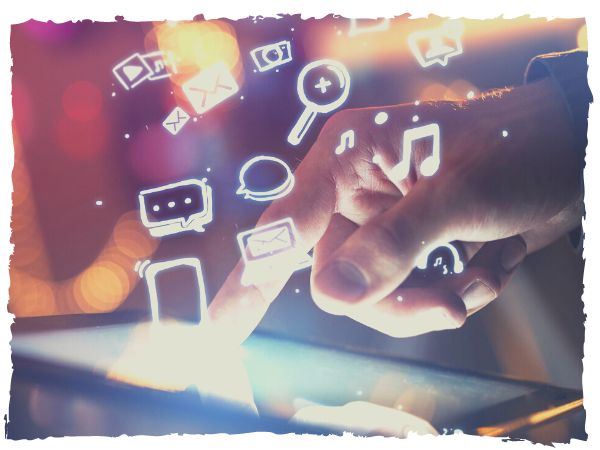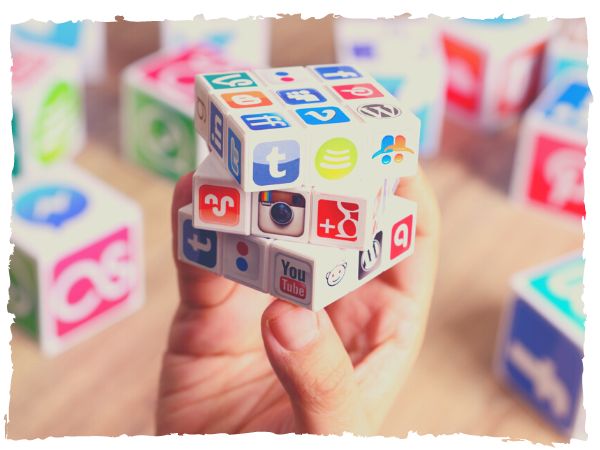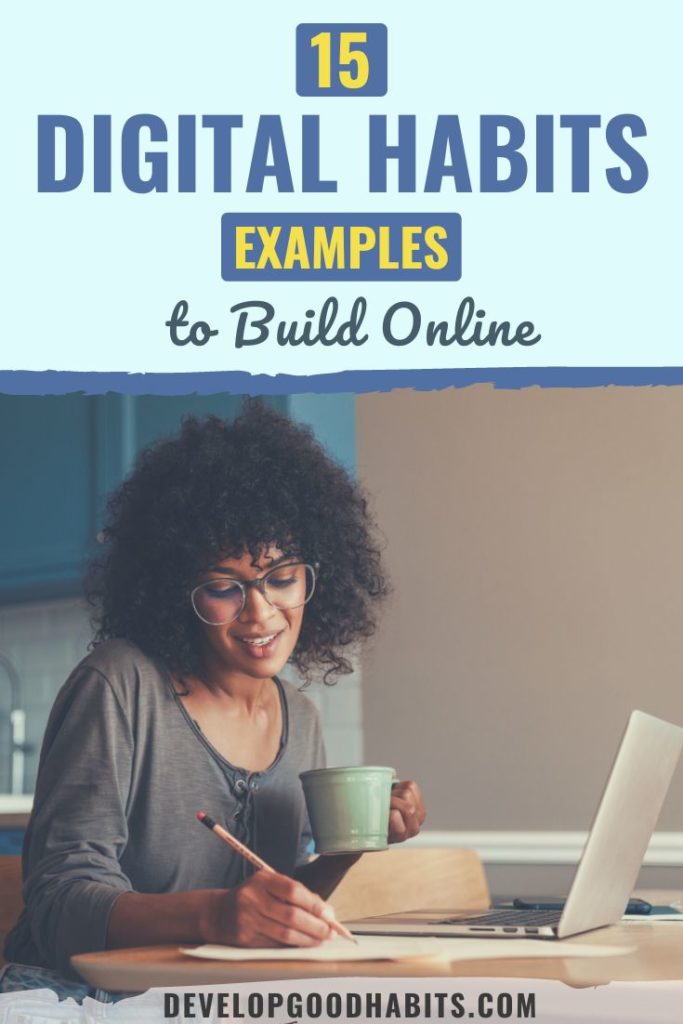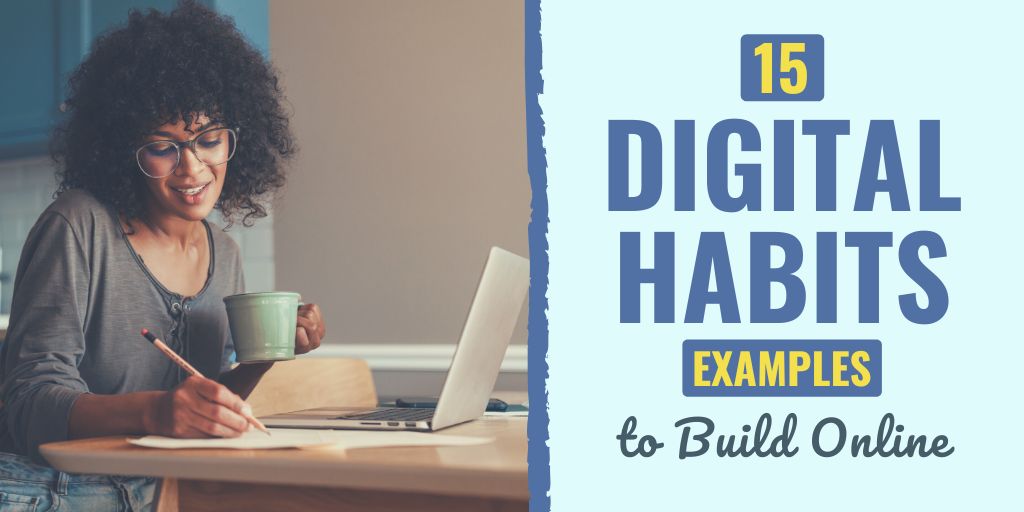Have you ever just watched people and their digital habits? I did; quite recently, in fact.
At a family gathering, I noticed how my cousin’s kids were all super glued to their smartphones. They were even chatting to each other on the devices – texting, when they were in talking range! I even caught my mom hiding in the kitchen and scrolling through her social feeds. My partner couldn’t wait to pick his phone up to reply to some work emails – on a weekend! No, sir!
These are just some digital habits examples. Not good habits by any means though.
What digital habits do you have? Do you fare better than falling asleep while mindlessly scrolling through Instagram, and do you religiously back up your data and use different passwords?
So while technology has made our lives easier in countless ways, we’ve also developed some really bad habits concerning digital technology that have made us lazy, unproductive, and fueled our procrastination tendencies that reinforce how disconnected we are from ourselves, our loved ones, and reality.
It’s time to STOP. It’s time to BUILD good and healthy digital habits. Here’s how.
What Are Digital Habits?
Digital habits are any healthy or unhealthy habits or behaviors concerning your use of digital technology: digital devices and media. In this light, digital habits are loosely related to digital etiquette, or netiquette: electronic rules that guide how you use technological devices and interact with others.
Healthy digital habits include limiting your use of social media, not using blue light technology before going to bed, and being responsible with your data and passwords. On the other hand, unhealthy digital habits include being addicted to your phone, allowing your inbox to be cluttered with unnecessary subscription mails, and having hundreds of (unused) apps on your devices.
Did you know that according to a 2021 survey, 46% of the respondents said they spend an average of 5 to 6 hours on their phones every day? These add up to 2,007 hours a year, which equates to 33% of our waking hours or 17 years of our lives. That’s staggering.
We do need our digital devices and media to make our lives more convenient and easy, since we benefit from being able to shop and exercise online, keeping in touch with our loved ones, practicing mindfulness and guided meditations, and working.
However, we also need to be mindful of the negative effects all things digital have on our lives – physical, emotional, and mental.
A love-hate relationship with technology is all good and well, but wouldn’t it be nice to appreciate technology while you engage in healthy habits?
Why Are Good Digital Habits Important for Success and Your Well-Being?
Healthy digital habits are essential if you want to be successful and enjoy a good overall well-being. I mean, there’s a reason why successful people like CEOs and those in other powerful positions in society have strict habits regarding their use of technology.
For example, Tim Cook (Apple CEO) and Hans Vestberg (Ericsson CEO) check their mail only in the early morning and not whenever a new mail comes in. CEOs also generally don’t multitask, believing it creates too much chaos. These successful folks believe that their focus should be reserved for important aspects of their lives, which is also why they choose quality over quantity.
Here are the most important benefits a good digital well-being, which you achieve with healthy digital habits:
15 Digital Habits Examples You Need to Build for Peace and Success
Technology is a big part of our everyday lives, and it’s likely that digital media and devices will continue to have a more significant part to play in our lives.
Build these digital habits so you can stop letting technology dictate your life and instead work smarter with it.
Habit 1. Limit Your Screen Time
One of the first healthy digital habits examples is to limit your screen time.
This isn’t easy since you can easily become addicted to using technology. It’s estimated that 40% of people have some kind of digital addiction, and breaking bad habits or addictions is challenging.
So start by setting yourself a goal that’s reasonable, and start slow. You don’t have to quit cold turkey, unless that works for you, but decide how many hours you can reasonably be away from your digital devices a day.
When you aren’t using your smartphone or PC, keep yourself busy with work or self-care. The more you enjoy what you are doing, the less you’ll think about being online – and the less you’ll want to be online.
Habit 2. Turn off Notifications
Do you reach for your phone as soon as you see it light up with a notification? And before you’ve even consciously thought you want to see what the notification is about, the phone’s in your hand, possibly even unlocked so you can reply to the message or mail, check out your bestie’s new status on Facebook, or pick up some pumpkins from the game you are playing.
Every time you pay a notification one ounce of attention, your productivity leaves the room.

According to statistics, the average smartphone user gets 46 notifications a day. Okay, that doesn’t sound like many, but that’s 5 to 6 notifications per hour during an 8-hour work day. And you aren’t just distracted for 46 minutes with those notifications – its way longer.
To take back control of your time, focus, and productivity, turn off notifications from non-essential apps (or all of them). No notifications mean you likely won’t check your phone so often, which is a good thing – no more compulsively picking up your phone.
Pro Tip: Especially turn off notifications when you need to work undisturbed. (#You’reWelcome)
Habit 3. Delete Your Apps
Can you honestly say you use all the apps on your PC, phone, and tablet? Really?
Yeah, I thought so. We all have extra apps on our devices that we think we’ll use when we download them, but then we never do. Or we use it once or twice, but never remove or uninstall them.
Make a list of the apps you do actually use and that add value to your life (be honest).
Then delete the apps you don’t use. This ensures you don’t get push notifications from apps you don’t use. Practicing digital minimalism helps you feel calmer and more organized.
Habit 4. Go Grayscale
Part of the problem with digital addiction is that everything is in color, which makes everything that much more enticing. Would you really want to play Candy Crush or the hottest and latest new game if it was in black, gray, and white? Well, maybe if you want to fall asleep.
In fact, your phone has the same allure as a slot machine in a casino – meant to keep your attention on the device. It’s a marketing tactic.
To help you spend less time on your phone, remove digital temptations, and create healthy digital habits, switch your phone to grayscale.
On Android devices, you can (usually) do this via the Accessibility menu.
On iOS devices (the latest iOS version), you need to go to Settings, and then Accessibility, Display and Text Size, and Color Filters.
Habit 5. Prioritize Quiet Time
Prioritizing quiet time is related to limiting your screen time. But it bears repeating.
You need some digital downtime every day, so decide what works for you. Switch off your phone before you head to bed and then switch it on only in the morning after you’ve finished your morning routine.
This allows you to focus on getting in the right mindset in the morning (without digital distractions) and you have more time to get ready without feeling rushed.
Or you can turn off your phone during lunch hour and enjoy a sit or walk out in nature while you enjoy your lunch.
Habit 6. No Tech in the Bedroom
It’s been proven that blue light exposure decreases how much melatonin (the drowse-making hormone) your body produces, which unfortunately, has a negative impact on your sleep. The artificial light actually makes your brain think it's daytime, so your brain revs up, ready to work and be awake.
A healthy digital habit is to avoid anything that emits blue light after 8 p.m. so your brain can wind down, and you can get the rest you are worthy of. Establish good sleep hygiene to help you sleep better.
Habit 7. Choose a Dumb Phone
You’re going to laugh because a dumb phone is the total opposite of a “smart” phone – and it’ll feel like you stepped back to the ice age of mobile devices. But it’s all for a good cause – remember, establishing good habits to improve your well-being and so on.
A dumb phone, also called a feature phone, doesn’t have the “smart” functionality of the phones from today. You can only use the device to call and text.
The good news is you don’t need to go out and buy a special pre-smartphone. Make your smart device “dumb” by deleting all apps except the Settings, Call, and Text apps.
Pro Tip: Turn off Wi-Fi and mobile data, so you aren’t tempted to download apps and make your phone smart again.
Habit 8. Ditch Social Media
You may feel like social media makes you feel more connected with your 1,780 friends. In fact, apps like Facebook and Insta make you more disconnected and lonelier than ever.

Of the hundreds or thousands of “friends” you have online, only a handful are real, genuine friends. And you don’t need to be on social media platforms to connect and stay in touch with your true friends. You can text, mail, call, or Zoom with them.
Many people are ditching social media; you can be one of them. Plus, no social media decreases the distractions of being on your phone for hours, helping you build healthy habits.
Habit 9. Turn the Brightness Down
Another great digital habit is to turn down the brightness on your devices. There’s no need for your phone or PC screen to be as bright as the light in the room or the sun.
When the light is bright on your screen or monitor, you tend to blink less, which causes your eyes to dry out easier. It’s also not healthy to have your devices on the lowest brightness setting and strain to see, so you’ve got to find the balance.
Plus, when your devices aren’t so bright, it helps your device save energy, which is good for your battery and the environment. (#Win-Win)
Habit 10. Wear Blue Light Filtering Glasses
If you are exposed to too much blue light over a long period of time (which is bound to happen if you work on your PC for the majority of your work day and then spend loads of time on your phone during leisure time), you can suffer from vision problems. Long-term blue light exposure causes damage to your retinal cells.
So get some blue light filtering glasses to help protect your eyes when you work on your PC, tablet, or phone. If you wear glasses, get blue light filtering lenses.
Habit 11. Consider a Digital Detox
A great digital habit to create is to regularly do a digital detox. A detox from technology helps you cultivate healthy relationships with your devices and digital media.
There are various options for a digital detox. It can be a set time every day, like during your commute to work, when you work out at the gym, or when you have lunch and dinner. Or you can choose a week with no devices every few months, or while you’re on vacation. Another alternative is to have a no technology policy for 45 or 90 days (or longer).
Taking a break from technology allows you to refocus, create other healthy habits in your life, and see technology through healthy lenses.
Habit 12. Unfollow Subscription Lists and Clear Your Inbox
Another good digital habit example is to clear your inbox. The simplest way to do that is to unsubscribe from all those newsletters and whatnot you signed up for (#SayNoToSpam).
Do you even read these emails? Or do they just create clutter and mess?
Bet you don’t read them. Maybe flag them or leave them unread, thinking you’ll get to it later. But you never do.
So try to get to inbox zero (#UltimateGoal). Unsubscribe, and feel more productive to get to the mails you are going to read and reply to.
Habit 13. Unclutter Your Home Screen
Successful people don’t have an overfull home screen. They only have the most important apps on their home screen, and interestingly, these don’t hold allure.
Choose home-screen apps like navigation tools, phone calling, ride-sharing, and a calculator. Move the rest of your apps to the second page, or place them in folders. The more “challenging” it is to access an app, the less likely you are to use it. (#OutOfSight-OutOfMind)
Habit 14. Back up Your Data
Everyone hates it when they lose important data because they are always too busy to back up their documents and files. These days, it’s easy to back up your devices so you don’t lose sensitive information.
Either back up your data to a physical hard disk, or choose a cloud storage solution.
Habit 15. Declutter Digitally
Make digital decluttering a habit. Only keep the files and documents on your devices that you need and that are really important.
Get into the habit of asking yourself every few months what apps, files, and documents you can remove.
If there is data you need to keep but not on your PC, move that information to a storage device. The benefit is that your PC won’t be so full of clutter (unnecessary docs) but you still have access to the info when you need it.
Final Thoughts on Digital Habits Examples
There are numerous benefits to fostering healthy digital habits. Being so over reliant on technology and using it mindlessly doesn’t have any sensible advantages for you. Your well-being suffers, and so too does your focus, productivity, and success in life.
It’s time to revamp your technology-related habits, and focus on building digital habits that add value to your life! Curious about how to create healthy habits? Check out our ultimate guide on building new habits that stick.
P.S. #youcandoit!


